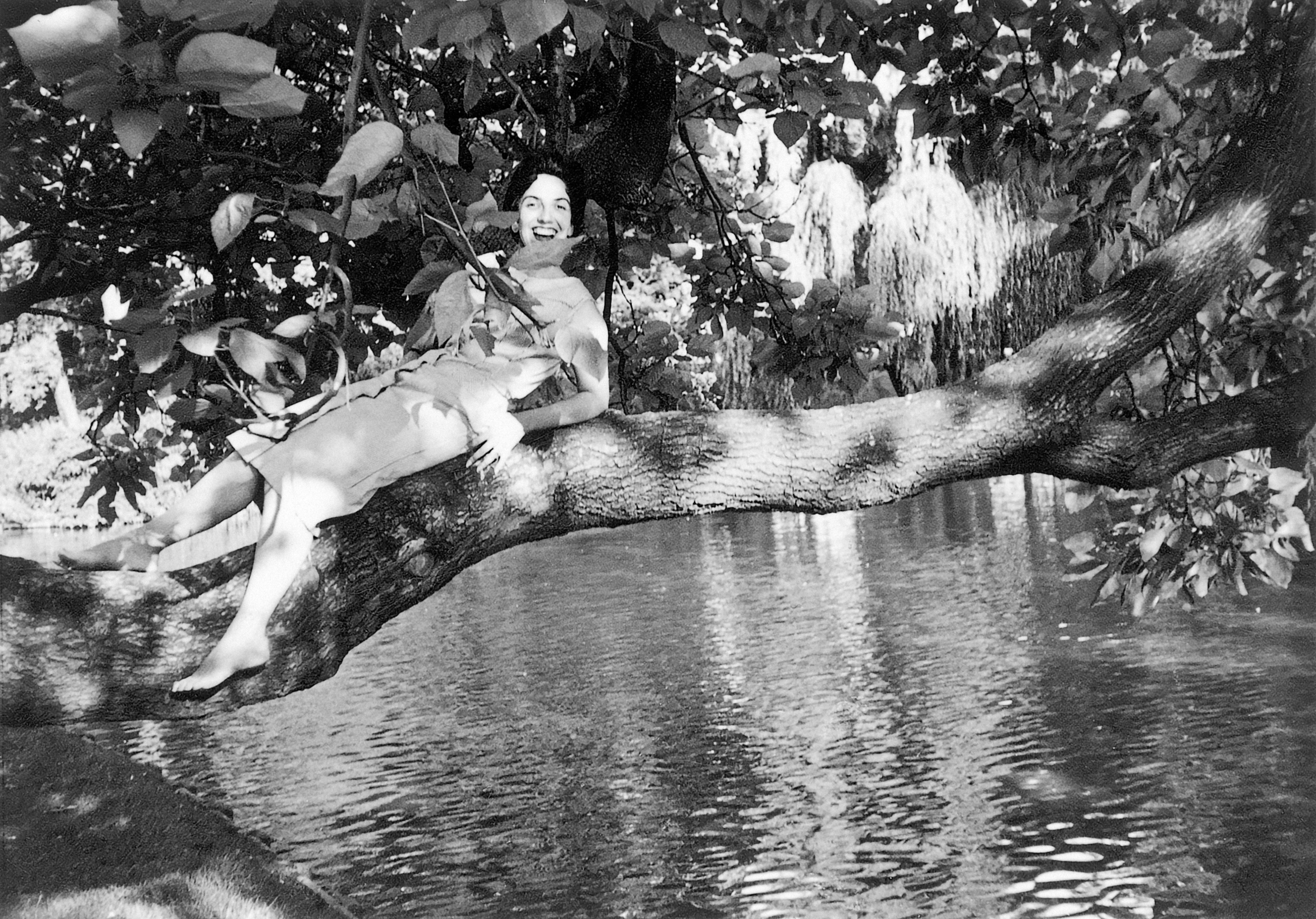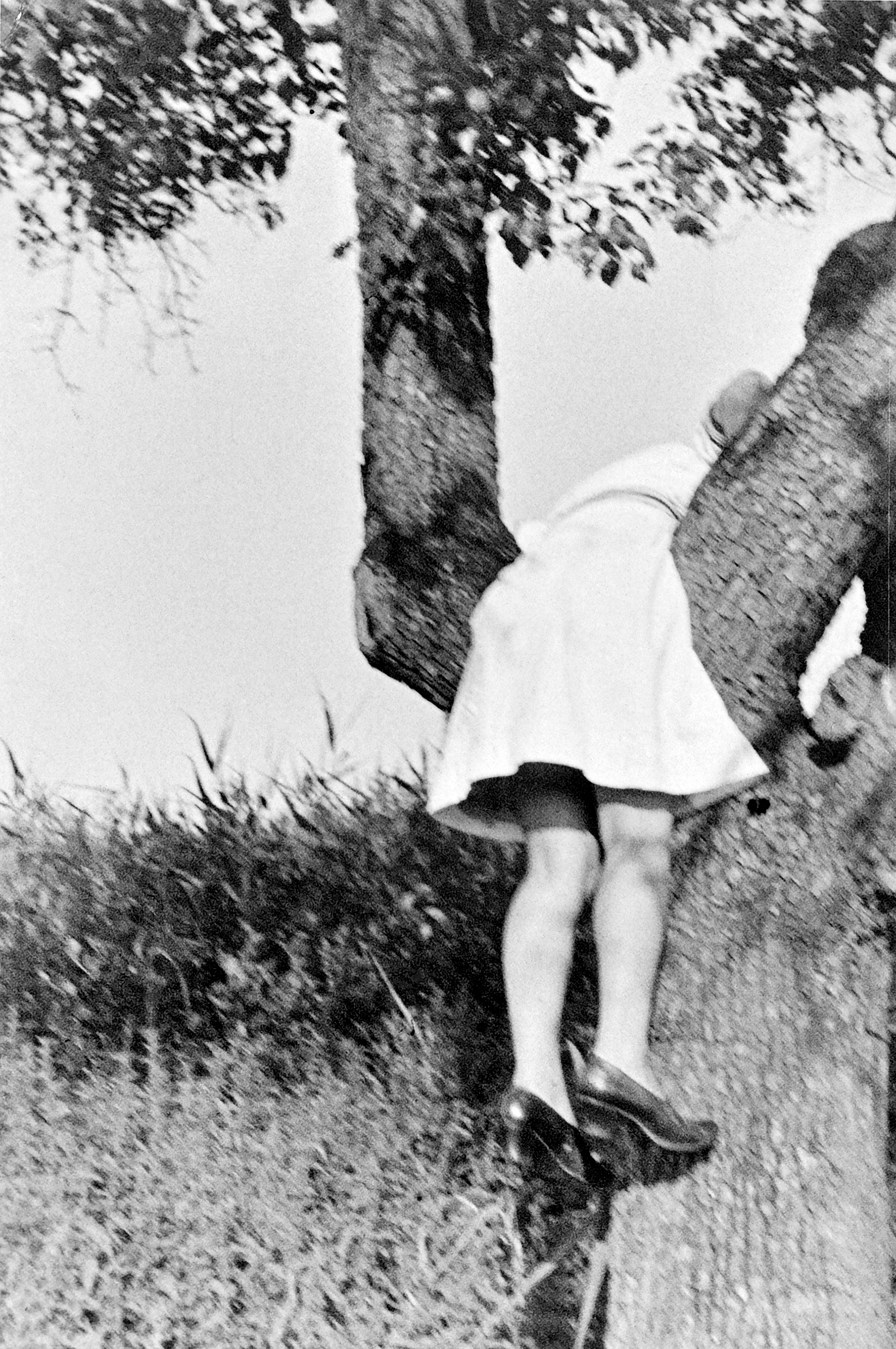The tension between trees and female disobedience is biblical. After succumbing to the snake’s suggestion and partaking of an apple from a tree, Eve gets some bad news: her body will bring her shame and pain. She is not meant to reach into trees or climb them; she should quietly remain on the ground and bear new life. Get down, history has said to the grown woman brazen enough to take even a brief arboreal leave from her earthly duties. Once a woman is off the ground, it may occur to her to keep on climbing. A man might find himself standing beneath her, subject to the sight of her womanly behind on a branch above his head.
To defy history and climb a tree as an adult woman is exhilarating. The German photographer Jochen Raiß discovered, through old photos he found at flea markets and in junk shops, that primly dressed women all over Germany, from the twenties to the fifties, posed in trees during Sunday strolls. His first volume of these found photographs, Women in Trees, became a best seller in 2016 and led to the recent sequel, the aptly titled More Women in Trees. Together, the two volumes contain nearly two hundred of Raiß’s amateur finds, all roughly dating from that time period when he estimates the phenomenon of German women posing in trees for their male companions was most popular. Cameras during this period, Raiß writes, were considered complicated machines best handled by men. And the mischievous smiles the women display in the photographs were most likely for their male companions behind the camera. Their expressions are often coy; there is a canned mischievousness to them—young women performing for boyfriends on a leisurely walk.
Even still, all these women, nearly a century ago, sitting in trees like the boys they never were are riveting. Hanging upside down or sitting on a branch extending over a river, many look euphoric, including one in the first volume perched alarmingly in a cactus. In the second volume, two women sipping beers together in a small tree appear as relaxed in their bower as if they were lounging in the living room of the house behind them.
Other women in the photographs look uneasy about straddling a branch in a hitched-up skirt, annoyed at having to endure the rough bark against their bare legs. In one image, the male photographer is standing close enough for his long shadow to fall eerily over the trunk of the tree, a shadow as large as the woman herself. What’s fascinating about viewing so many amateur images of the same curious phenomenon is the chance to guess from the women’s expressions and gestures what this fleeting moment of mischievousness a few feet off the ground meant to them, if it meant anything at all.
Raiß makes a vague reference in the first volume to the known unknowns of found photographs in general. In the second volume, he talks about how rare it was to find a date or name on the back of the photographs. The period of 1920 to 1950 is an estimate based on the cameras likely used for the photos. Raiß leaves unstated the fact that a good number of these photographs would have been taken in the lead-up to and during World War II. With no dates accompanying individual images, it’s impossible to know which of these women were supporters of Hitler and the Third Reich and which were among its victims. I couldn’t help wondering whether, contemporaneous with the women on their Sunday strolls, trains full of their fellow treed women were pulling into concentration camps.
“Time travel,” Zadie Smith writes in her essay “Optimism and Despair,” “is a discretionary art: a pleasure trip for some and a horror story for others.” Smith first presented the essay in Germany upon receiving an award there while reeling from the results of the 2016 presidential election in the United States. Flipping through More Women in Trees, I considered what people in the future might wonder about the voting habits of women posing for photographs in 2016. What questions will arise in forty years about how any of us appear in our canned photos uploaded to Instagram?
In a photo from the first volume, a woman poses with a pillow propped behind her head, as if she’ll remain on her chosen branch so long she’ll end up napping there. Her expression is defiant and ambitious: a desire to push the limits, even if she is most likely setting herself up for a painful fall. For the brute truth about humans in trees is that we cannot last there; gravity will bring a person down eventually. Inherent in every escape into a tree is the pending question of descent and how much humility it will demand. “Being a woman has only bothered me in climbing trees,” declared Frances Perkins, the first female cabinet member in American history. Perkins served as FDR’s secretary of labor from 1933 to 1945, the same era as the women in the photographs.
When I began my first novel, Ways to Disappear, with a woman in her sixties climbing into an almond tree, all I had in mind was her ascent. I thought as far as the decisive “no” she would reply to the man who approaches the tree and asks if she needs assistance. I gave her a cigar and a suitcase and knew the scene would end with her perched in her tree as gracefully as if she were awaiting a train in a station. It took me five years and 250 pages to get her out of the tree and seated at a table across from the adult daughter to whom she still could not bring herself to say the truth.
The novel became an exploration of far more kinds of vanishing than that initial, fleeting escape into a tree. The brazenness of that first arboreal escape, however, set the tone for all the other kinds of disappearing that followed. Even now, after reading that opening scene aloud at numerous book events across the U.S. and in other countries, I still feel a little more alive when I get to the line where my character takes a puff of her cigar and refuses to come back down.
A month after the 2016 election, while visiting my in-laws in Chile, I climbed a tree for the first time in years. I was staying at my sister-in-law’s house in an agricultural valley full of peach and apple orchards. At the time, I didn’t see my scrambling into that tree as an impulse to return to the fictional scene I had created several years before, although I suppose in part it was. Like my protagonist, I was feeling incapable of responding adequately to what reality currently required of me. At every meal and gathering in Chile, some friend or relative asked me how it was possible, how so many people in my country could vote for such a ridiculous, brazenly bigoted person for president. Are there really that many racists and people afraid of immigrants in the United States? they asked—although at this point, in December, after thousands of media takes on these questions all over the world, their inquiries were mostly rhetorical. I sensed that what my friends and family in Chile were really after was my acknowledgement of—and preemptive apology for—the harm the new administration was likely to inflict on our shared planet, and I gave it.
When the meal ended and I drifted off into the yard and climbed into a lemon tree, it was not because of any particular comment. It was more the accumulating pressure of my own sense of inadequacy and unease. I knew that wedging my middle-aged behind into the forked branches of a lemon tree would resolve nothing. But the fragrance of the lemons, the sensation of perching like some primal animal in a tree, felt restorative, even after my left leg went numb, even after my descent devolved into a protracted, painful, fumbling disaster.
As I flipped through ninety photographs of well-dressed German women posing in trees for men, the subtle differences in their gestures and expressions became increasingly potent and compelling. What did they shrug off and accept, and what did they question? Did the two women in floral dresses posing in a fallen tree’s large and twisted roots come into adulthood while Hitler was in power? One of them is smiling winsomely for whoever is behind the camera. But the other has turned her face away. Her gaze is solemn and fixed on something in the distance that remains beyond the frame.
Idra Novey is an award-winning poet and translator and the author of the novels Ways to Disappear and Those Who Knew, which is forthcoming in November.
All images © Sammlung Jochen Raiß
from The Paris Review http://ift.tt/2FWh9bA





Comments
Post a Comment